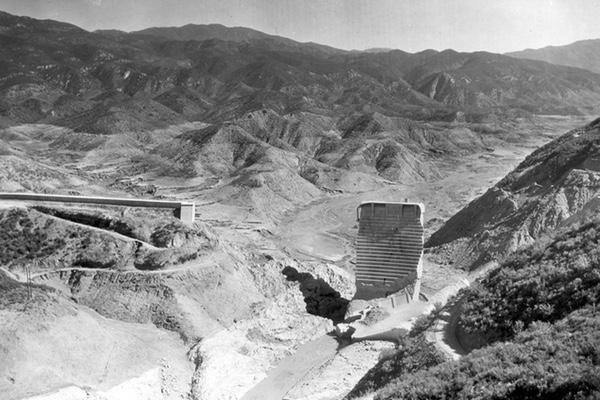Historians trying to draw attention to the neglected worst engineering disaster of the 20th century

St. Francis Dam Flood March 12-13, 1928, Los Angeles County, California. The remains of the dam and reservoir floor.
The remnants of the worst engineering disaster of 20th-century America sit about an hour’s drive from downtown Los Angeles. You head north on the 5, past the Hollywood Hills, into the San Fernando Valley, through the placid suburb of Santa Clarita. The familiar landscape of strip malls and palm trees gives way to something far more dramatic, a true West of roads cutting through narrow canyons. You feel small beneath the rising cliffs; you would feel smaller yet if nearly 15 stories of water were coming your way, the result of a public works project failing as few others have in the nation’s history.
Eighty-eight years ago, the St. Francis Dam burst in the middle of a March night, killing nearly 500 people. There are some images of the aftermath, but numbers tell the story better: 12.4 billion gallons of water rising to the furious height of 140 feet, surging 54 miles to the Pacific Ocean, an inland tsunami 2 miles wide leveling towns in its path. Some thought a saboteur had dynamited the dam. This would be easier to believe than the dam failing and people dying senselessly. But that was the case. And given the sorry state of American infrastructure, something similar could be the case again: the St. Francis Dam as portent, not aberration.
Whether there’s anything to be learned from the St. Francis Dam disaster is nearly immaterial, since so few people even know it took place. Two people are trying to change that: Alan Pollack, who runs the Santa Clarita Valley Historical Society, and Dianne Erskine-Hellrigel, who is behind the legislative push to have the dam site memorialized as a national monument and the surrounding federally managed forest turned into parkland. Back in January, they agreed to show me what remained of the dam. I was told not to wear good shoes.
The hills were turning orange in the rich winter light when we met, late in the afternoon of the appointed day. We wound through San Francisquito Canyon, on a sinuous road where there was no evidence of the notorious Los Angeles evening rush, then pulled off and started walking down another road, which had been abandoned about a decade ago. The forest had grown thick and unruly on either side, like a crowd held barely back from a Hollywood red carpet. We kept walking until the trees gave away. We were now on the canyon floor, on the spot where, in the waning minutes of March 12, 1928, the St. Francis Dam did precisely what it was engineered never to do.
The dam burst on its sides, so that a strangely picturesque center section remained, standing there as a lone man might on a deserted train platform. Morbidly nicknamed “the Tombstone,” this vertical slab of concrete was dynamited to bits after a boy climbing the structure fell and died (another boy had thrown a snake at him). The stated reason for the demolition was public safety, but as Jon Wilkman wrote in his excellent book on the St. Francis Dam disaster, Floodpath, “it was a memorial to a failure the leaders of Los Angeles preferred to forget.” ...